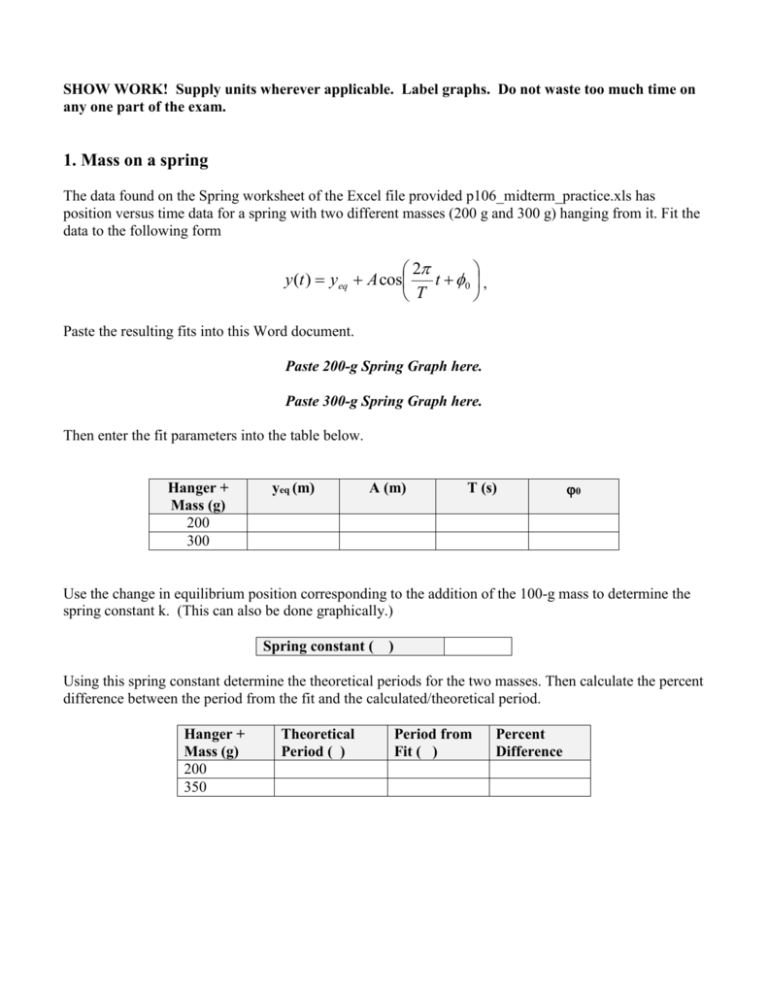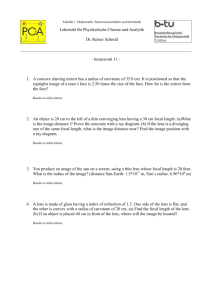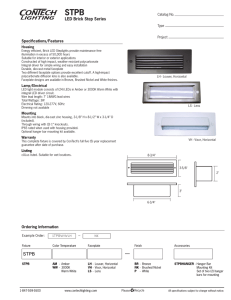Practice Midterm Exam
advertisement

SHOW WORK! Supply units wherever applicable. Label graphs. Do not waste too much time on any one part of the exam. 1. Mass on a spring The data found on the Spring worksheet of the Excel file provided p106_midterm_practice.xls has position versus time data for a spring with two different masses (200 g and 300 g) hanging from it. Fit the data to the following form 2 y (t ) yeq A cos t 0 , T Paste the resulting fits into this Word document. Paste 200-g Spring Graph here. Paste 300-g Spring Graph here. Then enter the fit parameters into the table below. Hanger + Mass (g) 200 300 yeq (m) A (m) T (s) 0 Use the change in equilibrium position corresponding to the addition of the 100-g mass to determine the spring constant k. (This can also be done graphically.) Spring constant ( ) Using this spring constant determine the theoretical periods for the two masses. Then calculate the percent difference between the period from the fit and the calculated/theoretical period. Hanger + Mass (g) 200 350 Theoretical Period ( ) Period from Fit ( ) Percent Difference 2. Lens In the ray diagram below, the arrow represents an object; the vertical line represents a converging lens; and the dots represent the focal points of the lens. Use the ray diagram rules to locate the image. 3. Critical Angle Determine the critical angle for Silicon assuming Silicon has an index of refraction of 4.01. Show work and/or give reasoning. 4. Lens Compute the focal length f of a lens from the data in each row of the following table. Then calculate the average focal length and the standard deviation. (This data can also be found on the lens sheet of the Excel file p106_s13_midterm_A.xls.) p (cm) 37.5 22.5 50.6 19.4 62.0 18.3 50.8 19.2 72.5 17.4 q (cm) 22.2 37.6 19.2 50.5 18.3 61.9 19.3 50.4 17.3 72.4 f( ) Average f ( ) Standard deviation ( ) 5. Linear Mass Density Determine the linear mass density of the tube provided. Explain. Explain 6. Standing Wave on a String The data below was taken for a string driven by a speaker on one end and attached to a hanger with a mass causing a tension on the other end. The mass was varied. For each mass two frequencies that gave rise to standing waves were found. The distance between nodes was measured for those standing wave patterns. Mass causing tension (includes hanger) (g) Frequncy (Hz) Node-to-node distance (cm) 200 20 40.6 200 27 30.6 250 23 39.5 250 30 30.2 300 25 39.4 300 34 29.4 350 27 39.8 350 37 29.1 400 28 41.0 400 39 29.5 Speed (m/s) Calculate the speeds of the waves above and then plot the speed versus tension. Fit it appropriately and compare it to theory. Paste graph here. Compare to theory. 7. Pendulum You want a pendulum that has a period of 2.46 s determine the necessary mass, mass and amplitude and enter them into the table below. Mass ( ) Length ( ) Amplitude ( ) Show work/Explain 8. Snell On the attached sheet you will find the paths taken by white light as it passed from air into a transparent triangular-shaped prism and back into air. Using a protractor, make measurements to test the Law of Reflection. Explain your reasoning and clearly indicate what measurements you made on the sheet. Next perform measurements to calculate the material’s index of refraction n. n( ) Explain your reasoning.






